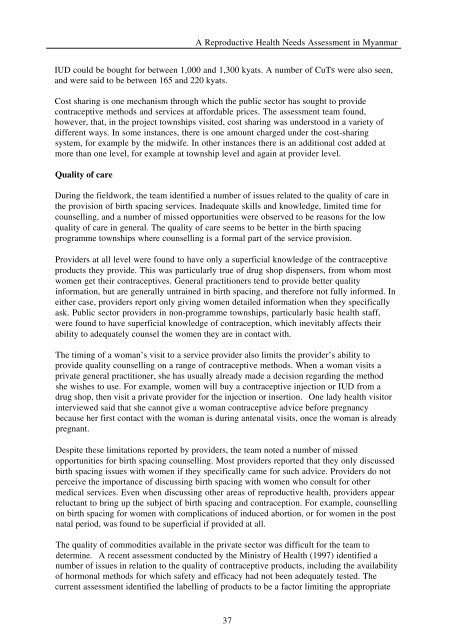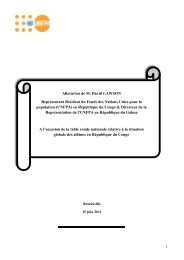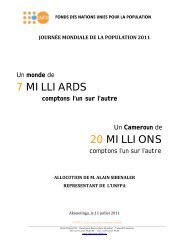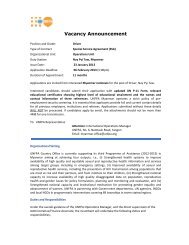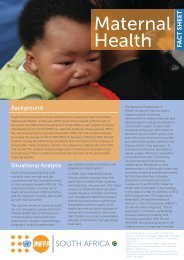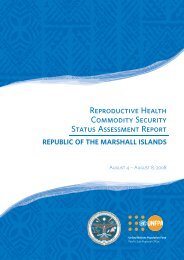A reproductive health needs assessment in Myanmar
A reproductive health needs assessment in Myanmar
A reproductive health needs assessment in Myanmar
Create successful ePaper yourself
Turn your PDF publications into a flip-book with our unique Google optimized e-Paper software.
A Reproductive Health Needs Assessment <strong>in</strong> <strong>Myanmar</strong><br />
IUD could be bought for between 1,000 and 1,300 kyats. A number of CuTS were also seen,<br />
and were said to be between 165 and 220 kyats.<br />
Cost shar<strong>in</strong>g is one mechanism through which the public sector has sought to provide<br />
contraceptive methods and services at affordable prices. The <strong>assessment</strong> team found,<br />
however, that, <strong>in</strong> the project townships visited, cost shar<strong>in</strong>g was understood <strong>in</strong> a variety of<br />
different ways. In some <strong>in</strong>stances, there is one amount charged under the cost-shar<strong>in</strong>g<br />
system, for example by the midwife. In other <strong>in</strong>stances there is an additional cost added at<br />
more than one level, for example at township level and aga<strong>in</strong> at provider level.<br />
Quality of care<br />
Dur<strong>in</strong>g the fieldwork, the team identified a number of issues related to the quality of care <strong>in</strong><br />
the provision of birth spac<strong>in</strong>g services. Inadequate skills and knowledge, limited time for<br />
counsell<strong>in</strong>g, and a number of missed opportunities were observed to be reasons for the low<br />
quality of care <strong>in</strong> general. The quality of care seems to be better <strong>in</strong> the birth spac<strong>in</strong>g<br />
programme townships where counsell<strong>in</strong>g is a formal part of the service provision.<br />
Providers at all level were found to have only a superficial knowledge of the contraceptive<br />
products they provide. This was particularly true of drug shop dispensers, from whom most<br />
women get their contraceptives. General practitioners tend to provide better quality<br />
<strong>in</strong>formation, but are generally untra<strong>in</strong>ed <strong>in</strong> birth spac<strong>in</strong>g, and therefore not fully <strong>in</strong>formed. In<br />
either case, providers report only giv<strong>in</strong>g women detailed <strong>in</strong>formation when they specifically<br />
ask. Public sector providers <strong>in</strong> non-programme townships, particularly basic <strong>health</strong> staff,<br />
were found to have superficial knowledge of contraception, which <strong>in</strong>evitably affects their<br />
ability to adequately counsel the women they are <strong>in</strong> contact with.<br />
The tim<strong>in</strong>g of a woman’s visit to a service provider also limits the provider’s ability to<br />
provide quality counsell<strong>in</strong>g on a range of contraceptive methods. When a woman visits a<br />
private general practitioner, she has usually already made a decision regard<strong>in</strong>g the method<br />
she wishes to use. For example, women will buy a contraceptive <strong>in</strong>jection or IUD from a<br />
drug shop, then visit a private provider for the <strong>in</strong>jection or <strong>in</strong>sertion. One lady <strong>health</strong> visitor<br />
<strong>in</strong>terviewed said that she cannot give a woman contraceptive advice before pregnancy<br />
because her first contact with the woman is dur<strong>in</strong>g antenatal visits, once the woman is already<br />
pregnant.<br />
Despite these limitations reported by providers, the team noted a number of missed<br />
opportunities for birth spac<strong>in</strong>g counsell<strong>in</strong>g. Most providers reported that they only discussed<br />
birth spac<strong>in</strong>g issues with women if they specifically came for such advice. Providers do not<br />
perceive the importance of discuss<strong>in</strong>g birth spac<strong>in</strong>g with women who consult for other<br />
medical services. Even when discuss<strong>in</strong>g other areas of <strong>reproductive</strong> <strong>health</strong>, providers appear<br />
reluctant to br<strong>in</strong>g up the subject of birth spac<strong>in</strong>g and contraception. For example, counsell<strong>in</strong>g<br />
on birth spac<strong>in</strong>g for women with complications of <strong>in</strong>duced abortion, or for women <strong>in</strong> the post<br />
natal period, was found to be superficial if provided at all.<br />
The quality of commodities available <strong>in</strong> the private sector was difficult for the team to<br />
determ<strong>in</strong>e. A recent <strong>assessment</strong> conducted by the M<strong>in</strong>istry of Health (1997) identified a<br />
number of issues <strong>in</strong> relation to the quality of contraceptive products, <strong>in</strong>clud<strong>in</strong>g the availability<br />
of hormonal methods for which safety and efficacy had not been adequately tested. The<br />
current <strong>assessment</strong> identified the labell<strong>in</strong>g of products to be a factor limit<strong>in</strong>g the appropriate<br />
37


